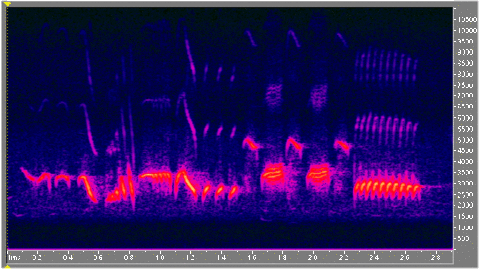Integrative Approach
Sociality
Optimal foraging
Space use behavior
Agonistic behavior
Reproductive behavior
Behavior
Habitat use
Species distribution
Ecological niche
Ecology
My research aims to integrate the diverse evolutionary processes driven by interspecific competition to provide a better understanding of their dynamic in coexistence mechanisms. More particularly, I am interested in the competition between closely related species: how do they interact, and how do their ecological, agonistic and reproductive traits evolve?
This broad approach to these dynamic interactions allows me to disentangle different character displacement processes (ecological, agonistic and reproductive) and determine the relative order of response of these traits in mammals, insects and reptiles.
Communication signal
Morphology
Diet
Other
phenotypic
traits
Multidisciplinary techniques

To test the effect of urbanization on acoustic space and signal, we determine the characteristics of environmental acoustic and of the Blue tit and Great tit songs in cities and associates forests.
Song recording and analysis
Playback behavioral experiment
To test if urbanization constraints shape interspecific competition between Blue tits and Great tits, we test in natura the behavioral response toward different song characteristics.


Radiotracking
To determine the space use and social behavior of the two studied Rhabdomys species, I radiotracked the mice during their diurnal foraging phase and nocturnal resting in nests.
This technique is associated with the capture-mark-recapture (CMC) of each individual.

Robotic behavioral experiment
To determine the presence of Agonistic Character Displacement process, I study the evolution of display behavior in Anolis lizard by using mimetic robots whose characteristics represent each species -A. oculatus and A. cristatellus-.
I present the robots to the lizards in the field, which allows me to record undisturbed and natural behavior directed towards a standardized conspecific versus heterospecific signal.

Genetic sequencing
The genetic sequencing is now an essential tool in Ecology and Evolution. In my research, the sequencing of tail samples allows me to determine the species identity and presence of hybrids in Rhabdomys mice and Anolis lizards.
Collaborators:
Pr. Jonathan Losos (Harvard University)
Dr. Anthony Herrel (MNHN Paris)
Dr. Dave Clark (Alma College)

Radiotracking
To determine the space use and social behavior of the two studied Rhabdomys species, I radiotracked the mice during their diurnal foraging phase and nocturnal resting in nests.
This technique is associated with the capture-mark-recapture (CMC) of each individual.

Robotic behavioral experiment
To determine the presence of Agonistic Character Displacement process, I study the evolution of display behavior in Anolis lizard by using mimetic robots whose characteristics represent each species -A. oculatus and A. cristatellus-.
I present the robots to the lizards in the field, which allows me to record undisturbed and natural behavior directed towards a standardized conspecific versus heterospecific signal.

Genetic sequencing
The genetic sequencing is now an essential tool in Ecology and Evolution. In my research, the sequencing of tail samples allows me to determine the species identity and presence of hybrids in Rhabdomys mice and Anolis lizards.

Spectrometry
The spectrometry technique is used to record the reflectance spectrum (i.e. objective proxi of color) of objects and organic structures. I use this technique to determine the evolution of Anolis dewlap color and analyze the spectrums by considering the visual perception of A. cristatellus and A. oculatus.

Habitat characterization
The characterization of the used and available habitats (in terms of structure, cover, densiometry, composition, ect), is a cornestone technique of my research, linking the habitat used by an individual to his behavioral, morphological and other life history traits.

GIS
I use the Geographic Information System (GIS) technique to understand the geographical scales of evolution. For example, I used this approach to determine and predict at fine (alpha) and large (beta) spatial scales, the ecological niche of the two species of Rhabdomys.

Laboratory behavioral experiments
My research also contributes to bridge the gap between field and laboratory behavioral experiments. Indeed, dyadic encounters (in Rhabdomys and Anolis) and mate choice (Rhabdomys and Asobara) experiments are integrated to the behavioral observations recorded in the field in order to determine the evolution of interspecific competition and sexual selection.

Morphological measurements
Body mass as well as body, head and limb size and shape are important candidate traits in the adaptation to new environmental pressures such as habitat shift.

Isotopic signature
The isotopic signature (in carbon and nitrogen) of hairs and plants sampled at the austral spring and fall, allows to determine the evolution of the relative diet of the two studied Rhabodmys species.
Once again, the analysis of the samples from the field is linked to a diet standardized laboratory experiment in order to control for species-specific metabolism.